小学英语全英文说课稿范例
- 格式:doc
- 大小:51.00 KB
- 文档页数:5
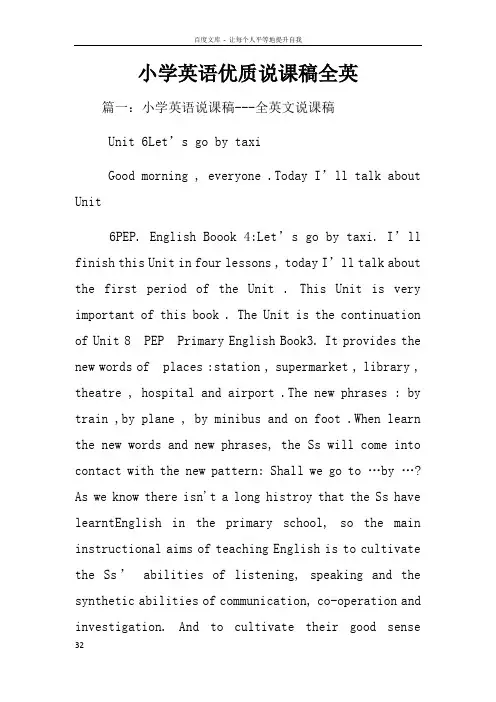
小学英语优质说课稿全英篇一:小学英语说课稿---全英文说课稿Unit 6Let’s go by taxiGood morning , everyone .Today I’ll talk about Unit6PEP. English Boook 4:Let’s go by taxi. I’ll finish this Unit in four lessons , today I’ll talk about the first period of the Unit . This Unit is very important of this book . The Unit is the continuation of Unit 8 PEP Primary English Book3. It provides the new words of places :station , supermarket , library , theatre , hospital and airport .The new phrases : by train ,by plane , by minibus and on foot .When learn the new words and new phrases, the Ss will come into contact with the new pattern: Shall we go to …by …? As we know there isn't a long histroy that the Ss have learntEnglish in the primary school, so the main instructional aims of teaching English is to cultivate the Ss’abilities of listening, speaking and the synthetic abilities of communication, co-operation and investigation. And to cultivate their good senseofEnglish.(本课是本册教材中较为重要的依棵,它是牛津小学英语3A第八单元知识的一个延伸。

小学英语全英文说课稿模板(附全英文示范说课稿)Today I’m going to talk about Part B of Unit 2, PEP Primary English, Book 3. This lesson includes two parts: Let’s talk and let’s practice. In section 1, it mainly deals with the dialogue about “What’s in the schoolbag?” and the answers. And in section 2, it provides a real situation for the Ss to prastise the pattern: How many +n.(pl.)+ do you have? And the answer: I have 23 +n.(pl.) II. Teaching aims1. Aims on the knowledge(1) To enable the Ss to understand and speak: “My scho olbag is heavy. What’s in it? Thank you sooooooo much.” Make sure that Ss can use these sentences in real situations. (2) To help Ss to finish the survey.(3) Let Ss finish the assessment of “Let’s check” in this unit. 2. Aims on the abilities(1) To devel op Ss’ abilities of listening and speaking. (2) To train the Ss’ ability of working in groups.(1) To help Ss ask and answer the question: What’s in it?(2) To enable Ss to study in groups and co-operate skillfully.(3) To develop Ss’ interest in English. IV. Difficult points(1) To help the Ss ask and answer the question “What’s in it?” and make sure they can use the plural nouns correctly.(2) To finish the survey by themselves. V. Teaching methods1. Free talk between T and Ss about things in the classroom.2. Sing the song together: Books and pencils.3. Do some TPR, for e某ample: Show me your English book. Show me your crayon.4. Review the numbers by asking: “How many crayons do you have?”Step 2. PresentationNow I’ll mainly talk about this step.1. Pr esent the pattern: “My schoolbag is heavy.” “What’s in it?.”(1) Show a bag and say: “Look! I have a bag.” Carry it and say: “Oh, it is heavy. My schoolbag is heavy.” Help the Ss understand the meaning with the help of my body language. Then lead the Ss to read the sentence. Make sure they can say it correctly. (2) T: My schoolbag is heavy.Open the bag and say: “What’s in it? What’s in my schoolbag?”Take out a Chinese book. Then do the action again. Let the Ss read the sentence.Girl: 20 story-books, 32 pencil, 9 rulers, 12 crayons and 30 picture-books. Etc. Boy: What will you do? Girl: They are for the poor.Boy: Great! I’ll bring some school things too.4. Mention that we should take care of the poor.5. Play the cassette. Let the Ss listen and imitate the dialogue. Pay attention to their pronunciation and intonation.Purpose: CAI can provide a real situation for the Ss to understand the dialogue and the relationships between people better. Tell the Ss we should show our loveliness to the Ss. Step 3. PracticeHelp Ss finish “Let’s check” of this unit and workbook.Purpose: To check the knowledge Ss have learned in this period. Step 5. Add-activity1. Let Ss tell each other how many school things they have after class. Tell their parents how many school things they have at home.2. Take care of everything they have.Purpose: Revision is so important that Ss should speak English as much as they as in class or after class. It is necessary for the Ss to do some e某tensive e某ercises after class to consolidate the knowledge they learned.Today I’m going to talk about Part B of Unit 2, PEP Primary English, Book 3. This lesson includes two parts: Let’s talk and let’s practice. In section 1, it mainly deals with the dialogue about “What’s in the schoolbag?” and the an swers. And in section 2, it provides a real situation for the Ss to practisethe pattern: How many +n.(pl.)+ do you have? And the answer: I have … +n.(pl.)Teaching aims1. Aims on the knowledge(1) To enable the Ss to understand and speak: “My schoolbag is heavy. What’s in it? Thank you so much.” Make sure that Ss can use these sentences in real situations.(2) To help Ss finish the survey. 2. Aims on the abilities(1) To develop Ss’ abilities of listening and speaking. (2) To train the Ss’ ability of wor king in groups.(1) To help Ss ask and answer the question: What’s in it?(2) To enable Ss to study in groups and co-operate skillfully.(3) To develop Ss’ interests in English. Difficult points(1) To help the Ss ask and answer the question “What’s in it?” and make sure they can use the plural nouns correctly.(2) To finish the survey by themselves.Teaching procedures and purposes of my designing. I’ll finish this lesson in five steps. Step 1. Warm-up and preview1. Free talk between T and Ss about things in the classroom.2. Sing the song together: Books and pencils.3. Do some TPR, for e某ample: Show me your English book. Show me your crayon.4. Review the numbers by asking: “How many crayons do you have?”Step 2. PresentationNow I’ll mainly talk about t his step.1. Present the pattern: “My schoolbag is heavy.” “What’s in it?.”(1) Show a bag and say: “Look! I have a bag.” Carry it and say: “Oh, it is heavy. My schoolbag is heavy.” Help the Ss understand the meaning with the help of my body language. Then lead the Ss to read the sentence. Make sure they can say it correctly.(2) T: My schoolbag is heavy.Open the bag and say: “What’s in it? What’s in my schoolbag?”Girl: My schoolbag is heavy.。
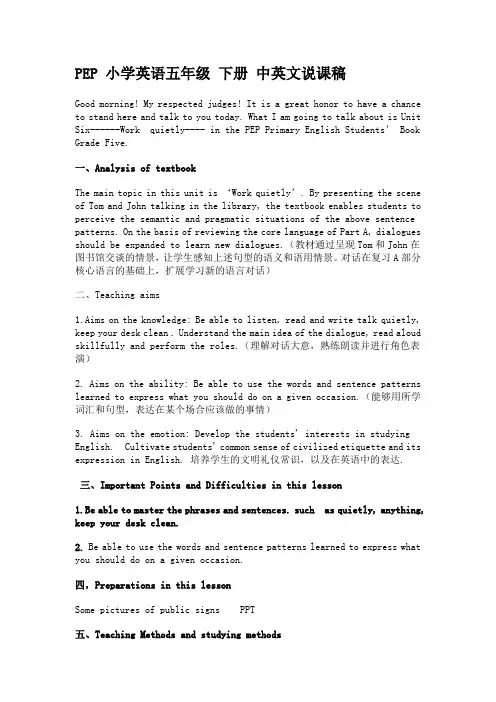
PEP 小学英语五年级下册中英文说课稿Good morning! My respected judges! It is a great honor to have a chance to stand here and talk to you today. What I am going to talk about is Unit Six------Work quietly---- in the PEP Primary English Students’ Book Grade Five.一、Analysis of textbookThe ma in topic in this unit is ‘Work quietly’. By presenting the scene of Tom and John talking in the library, the textbook enables students to perceive the semantic and pragmatic situations of the above sentence patterns. On the basis of reviewing the core language of Part A, dialogues should be expanded to learn new dialogues.(教材通过呈现Tom和John在图书馆交谈的情景,让学生感知上述句型的语义和语用情景。
对话在复习A部分核心语言的基础上,扩展学习新的语言对话)二、Teaching aims1.Aims on the knowledge: Be able to listen, read and write talk quietly, keep your desk clean . Understand the main idea of the dialogue, read aloud skillfully and perform the roles.(理解对话大意,熟练朗读并进行角色表演)2. Aims on the ability: Be able to use the words and sentence patterns learned to express what you should do on a given occasion.(能够用所学词汇和句型,表达在某个场合应该做的事情)3. Aims on the emotion: Develop the students' interests in studying English. Cultivate students' common sense of civilized etiquette and its expression in English. 培养学生的文明礼仪常识,以及在英语中的表达.三、Important Points and Difficulties in this lesson1.Be able to master the phrases and sentences. such as quietly, anything, keep your desk clean.2.Be able to use the words and sentence patterns learned to express what you should do on a given occasion.四,Preparations in this lessonSome pictures of public signs PPT五、Teaching Methods and studying methods1.Situational Teaching MethodDuring the teaching procedure, I make several situational conversations for the students. For example, I choose some students to do therole-playing game, and let them play the roles in the textbook, and make their own conversation by themselves according to their reality. By doing this game, the students can have chances to practice their oral English and join into the teaching procedure.(二) Interactive Teaching MethodGuessing game is one of activities in my teaching procedure. For example, the teacher makes body gestures, and the students guess what the gestures mean. By the interaction between teacher and students can avoid just the teacher’s talking, als o can activate atmosphere of the class, and let them learn English by games.(三) Task-based Teaching MethodIn the first lesson, I design a task for the students, for example. I ask the students to draw four pictures in spring, summer, fall and winter and put the words on the pictures. By doing this activity, the students can memorize the new words better.(四) Group Study MethodI divide the class into four groups and each group has its own name. Group study plays a very important role my lesson. By doing this, the students can study English in competitive cooperation.(五) Practice MethodPractice is very important. The students can not improve their English without practice, because practice makes perfect. By doing practice, the students can make full use of what they have learned in the class.三、 Teaching procedures(一)Warm-up(1) Guessing gameIn warming-up step, after the teacher and students greet each other, the teacher begins to make body gestures on weather, such as cold, hot, warm, cool, rainy, windy, cloudy and so on., and asks the students what is the weather like now. And the students guess what kind of weather it is. Suchas making a hot weather gesture, the teacher keeps fanning with his hand; making a cold weather gesture, and the teacher keep shaking. Any student guesses the right answer will be awarded a red star for his group. This step helps students go over some words on weather, and makes preparation for the new lesson.(二) Lead-in(1) Learning the new wordsThe teacher takes out four typical pictures in spring, summer, fall and winter, and sticks them on the blackboard. Then the teacher asks the students what season is it, and puts the word ‘season’ on the blackboard, and teaches the students how to read it. Then the teacher points at spring picture, and asks students what season it is. The students may not know the word ‘spring’, but they can answer it “Chuntian” in Chinese, then the teacher writes down the word ‘spring’below the picture, and teaches them how to read it. Using the same way, the teacher teaches other new words. After that the teacher invites some students to stand up and read the new words several times.(2) Guessing GameIn this step, the students put the new words into practice. The teacher chooses a volunteer, and shows him a picture of tree, and he draws the picture, and other students guess what season it is based on the picture the volunteer draw. Anyone who guesses right will be awarded a red star for his group. Every group has one chance to answer the question.(3) Task: Drawing picturesIn this step, the teacher requires every student drawing four pictures in spring, summer, fall and winter, and putting the new words on them.(4) Showing the mapIn this step, the teacher takes out a big map, and sticks it on the blackboard, and shows the students some cities on the map, such as Lhasa, Beijing, Shenzhen, Kunming, Harbin, and Jianshui, and begins another Guessing game: the teacher asks “what is the w eather like inLhasa/Shenzhen/Kunming/Harbin/Jianshui in spring/summer/fall/winter”. The students use “it is windy/sunny/warm/cold/hot/warm/cool” answering the questions. Anyone who guesses right will be awarded a red star for his group.(5) Role-playingIn this step, I choose some students to do the role-playing game, and let them play the roles in the textbook, and make their own conversation by themselves according to their reality. Each group at least makes a conversation. Such as:Converstion1A: which season do you like best?B: winterA: why do you like winter?B: Because I like snows.Conversation 2A: what is your favorite season?B: I like summer.A: why do you like summer?B: Because I like swimming.Anyone who does well will be awarded a red star for his group.(6) Let’s chantThe teacher plays the tape of Let’s chant, and the students follow the tape to chant together for two time. Then the teacher explains what the chant means. And chant it again.(7) Counting the red stars of each groupCongratulations to the winner group, and give them applauses.(8) HomeworkEach student is required writing the new words and four sentences patterns two times.(9) Blackboard writing planUnit 2 What is your favorite season1. Season, spring, summer, fall, winter.2. What is your favorite season/which season do you like best. I like..... 3.Why do you like ….? Because…….4. What is the weather like in …..? It is …….5. What season is it? It is ……四、My teaching plan conceptsLet students study English in situational conversation; let students study English competitive cooperation; let students study English in happiness; Let students have no fear in studying English.。
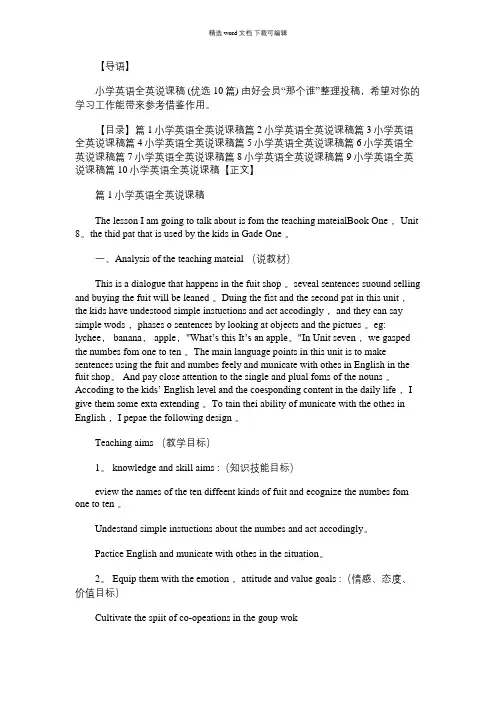
【导语】小学英语全英说课稿 (优选10篇) 由好会员“那个谁”整理投稿,希望对你的学习工作能带来参考借鉴作用。
【目录】篇1小学英语全英说课稿篇2小学英语全英说课稿篇3小学英语全英说课稿篇4小学英语全英说课稿篇5小学英语全英说课稿篇6小学英语全英说课稿篇7小学英语全英说课稿篇8小学英语全英说课稿篇9小学英语全英说课稿篇10小学英语全英说课稿【正文】篇1小学英语全英说课稿The lesson I am going to talk about is fom the teaching mateialBook One ,Unit 8。
the thid pat that is used by the kids in Gade One 。
一、Analysis of the teaching mateial (说教材)This is a dialogue that happens in the fuit shop 。
seveal sentences suound selling and buying the fuit will be leaned 。
Duing the fist and the second pat in this unit ,the kids have undestood simple instuctions and act accodingly ,and they can say simple wods ,phases o sentences by looking at objects and the pictues 。
eg: lychee, banana, apple,"What’s this It’s an apple。
"In Unit seven ,we gasped the numbes fom one to ten 。
The main language points in this unit is to make sentences using the fuit and numbes feely and municate with othes in English in the fuit shop。

小学英语说课稿全英版Good morning, esteemed colleagues and judges. Today, I am excited to present a lesson plan for a primary school English class. The topic of this lesson is "My Family," which aims to engage second-grade students in a fun and interactive way while teaching them basic vocabulary and sentence structures related to family members.Objectives:By the end of this lesson, students will be able to:1. Recognize and pronounce the names of family members in English.2. Use simple sentences to talk about their family.3. Understand and use possessive adjectives to describe relationships within a family.4. Participate in a class activity that reinforces the learned vocabulary and grammar.Materials:- Flashcards with family member names and images.- A family tree poster or diagram.- Realia, such as family photos, to demonstrate the concept of family.- A storybook related to families, for example, "My Family and Other Animals" by Gerald Durrell.- Audio-visual equipment to play a song about families, such as "Family Fingers" by the Learning Station.Introduction (5 minutes):The lesson will begin with a warm-up activity. I will greetthe students and ask them how they are, using the opportunity to review basic greetings from previous lessons. To set the context for the lesson, I will show them a family photo and ask them to guess who the people are. This will naturallylead into the topic of "My Family."Presentation (15 minutes):Next, I will introduce the flashcards with the names offamily members, such as "mother," "father," "sister," "brother," "grandmother," and "grandfather." As I presenteach flashcard, I will encourage students to repeat the word after me, focusing on pronunciation. I will also use the realia, pointing to different members in a family photo and asking students to name them.To teach possessive adjectives, I will show the family tree and explain how we use "my" to show ownership or relationship, for example, "my mother" or "my brother." I will then elicit sentences from the students using these new words, such as "This is my sister" or "That is my grandmother."Practice (10 minutes):After the presentation, students will practice the new vocabulary in pairs. I will give them a handout with pictures of different family members and ask them to label thepictures with the correct family member names. Then, theywill practice introducing their families to each other using sentences like "I have a big family" or "My mother is a teacher."Production (15 minutes):For the production phase, I will divide the class into small groups and give each group a set of flashcards and a blank family tree diagram. The task is for the students to create their own family tree, discussing and deciding who belongs where. They will then present their family tree to the class, using sentences like "In my family, I have two sisters and one brother."Closure (5 minutes):To conclude the lesson, we will sing a song together related to families. This will not only reinforce the vocabulary but also provide a fun and memorable way to end the class. I will also review the key points of the lesson and ask the students to share one new thing they learned about families today.Assessment:The students' understanding of the lesson will be assessed through their participation in the activities, their ability to correctly use the new vocabulary and grammar structures, and their performance during the family tree presentation.Differentiation:For students who finish tasks early or show a higher level of proficiency, I will provide additional family-related vocabulary, such as "cousin," "aunt," and "uncle," and encourage them to expand their family tree. For students who need extra support, I will provide more one-on-one practice and use simpler sentences for the presentations.Homework:As homework, students will draw a picture of their family and write a short paragraph describing their family members, using the new vocabulary they learned today.In summary, this lesson plan is designed to be engaging and interactive, allowing students to learn about family members in English while practicing their speaking and listening skills. Through a variety of activities, students will have the opportunity to apply their knowledge in a fun and meaningful way. Thank you for your attention, and I look forward to implementing this lesson in the classroom.。
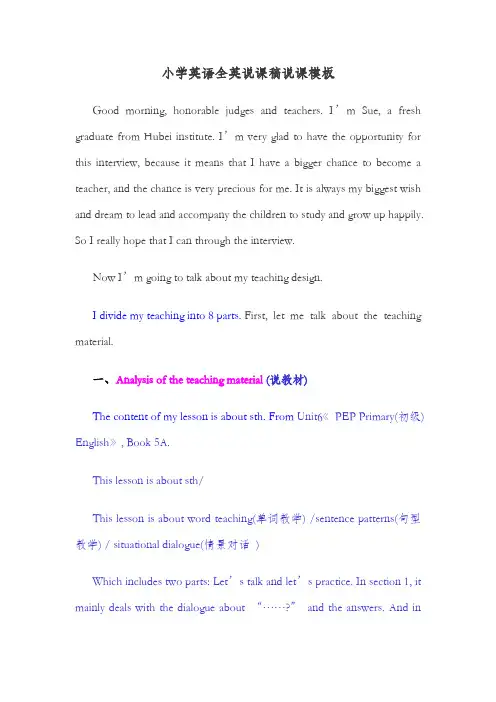
小学英语全英说课稿说课模板Good morning, honorable judges and teachers. I’m Sue, a fresh graduate from Hubei institute. I’m very glad to have the opportunity for this interview, because it means that I have a bigger chance to become a teacher, and the chance is very precious for me. It is always my biggest wish and dream to lead and accompany the children to study and grow up happily. So I really hope that I can through the interview.Now I’m going to talk about my teaching design.I divide my teaching into 8 parts.First, let me talk about the teaching material.一、Analysis of the teaching material (说教材)The content of my lesson is about sth. From Unit6《PEP Primary(初级) English》, Book 5A.This lesson is about sth/This lesson is about word teaching(单词教学) /sentence patterns(句型教学) / situational dialogue(情景对话)Which includes two parts: Let’s talk and let’s practice. In section 1, it mainly deals with the dialogue about “……?”and the answers. And insection 2, it provides a real situation for the Ss to practice the sentences: ……The main language point in this unit is to make sentences ……freely and communicate with others in English correctly.This lesson is about a ……topic. By study of this unit, the Ss know how to ask the ……in English and how to describe the ……with simple words and sentences. The sentence patterns of this lesson “……?”“……?”and“…….”are the key and difficult points of this unit. The study of this lesson will help the Ss with daily communication.This is the first period(['pɪərɪəd]时期) of Unit?. And it covers three parts (A, B and C).In part A. the students will learn a new word: ……. In part B. we'll learn the sentence patterns, because the sentences “……”the students have learned before, so the new sentence pattern for them is 'What for?’. Part C is the most important part in this lesson. It is just to teach the students …. And …will be taught next lesson.This is a dialogue that happens in somewhere .several sentences surround sth will be learned.This dialogue(或lesson) is close to the actual life of the students, which would attract the students’ curiosity [kjʊərɪ'ɒsɪtɪ] (好奇),interestand attention. And we pay attention to training the students’ability of the listening, reading and writing.二、Teaching aims (教学目标)Next part is teaching aimsAs we all know: the main instructional(教学) aim of learning English in primary school is to cultivate pupils’basic abilities of listening and speaking and their good sense of the English language, So I put forward the teaching objectives of this lesson as follows.1. Aims on the knowledge1) Aims on the knowledge is to enable the students to learn somenew words, such as …… and so on, and to master the sentence pattern s: “……"2) The Ss can understand and read the conversation(对话)of the lesson.2. Aims on the abilities(1)The ability aim is to enable the Ss to understand and speak: “…….”Make sure that Ss can use these sentences in real situations.(2) To develop Ss’abilities of communication and their innovation (创新).3. Aims on the emotion(1) The emotion aim is to foster Ss’consciousness(['kɒnʃəsnɪ(/ə)s]意识)of good co-operation and proper competition.2) By completing the task, the Ss increase their interest and set up self-confidence in language study;IV. Next, the key-points of this lesson(说重点)(1) The students study and use the sentence patterns “……”,and improve their abilities of listening,speaking ,reading and writing;(2) Teach the Ss how to study independently(独立的)as well as by cooperation(合作).(3) Develop Ss’interest in English.V. Difficult points(难点)(1) The students can understand the meaning of the new sentence patterns and use them correctly.(2) The Ss can use the words and patterns to describe the sth in the proper scene.((3) The students can finish the survey by themselves.)三、Analysis of the students(学情分析)Then I’ll talk about the analysis of the students.The students I’ll teach are the (fifth)-grade students. They are very active and they like singing, dancing and playing games.The students in Grade 5 have had some basic English knowledge and th ey can express themselves in simple English. They are eager(['iːgə]渴望) to learn more and have been interested in EnglishIn the past few years of study,the students have learned some words,phrases and some simple sentences.They have great interest in learning English now.四、Teaching aids(教学准备)Next part is teaching aids. In this lesson, I’ll use the pictures, word cards, Multimedia(['mʌltɪmiːdɪə]多媒体),and tape recorder. These can stimulate students’interest in English.五、Teaching methods(教学方法)Then I’ll talk about teaching methods.Well, how to achieve the teaching objectives better, how to stress(强调) the key points and overcome the difficult points? The answer is proper teaching methods,I’ll mainly use the TBLT method and situational approach in this lesson.It is known to us that the kids are very active and like playing games very much, so during my class, I’ll design some interesting games to stimulate the interest of the ss. And the students will use the active learning and cooperative learning六、Teaching procedure(教学过程)The Teaching procedures and purposes of my designingNow I’ll mainly talk about the most important part of the teaching design: teaching procedure. I’ll finish this lesson in four steps.Step1. Warm-up(热身)I will begin this lesson with a song. Sing a song will make students feel pleased and satisfied and also it can arou se their exciting emotion.Then I'll have a free talking with the students, because free talking is an important way to improve the students' ability of speaking. I’ll ask the students some questions like: What day is it today? What's the date today? What's your favourite subject? What do you like doing?this step is used to review the knowledge in the formerunits and make an atmosphere(['ætməsfɪə]气氛) of English learning.Step2. Presentation and practice(呈现新知)Firstly, present the new words:……and so on with the help of CAI. Ask students to watch and repeat the words.Secondly,show the pictures by PPT, ask the students practice the phrases:…… By acting and saying, the using of PPT makes the presentation of the words active, direct and vivid. It will help the students get a better understanding of the phrases.Thirdly, Watch a video (观看多媒体,了解本课故事情节),Present the situation to help the Ss know what's happening in the story . (This part is important and effective)It will provide a real situation for the students to understand themeaning of the new words better, and also it will arouse the students’ interest of English learning .Step3. Consolidation (巩固)First, I will ask them to make a dialogue with their partners, they can talk to several classmates who they want to co-operate with,so they can walk freely and speak loudly, in this way, they will feel happy and successful. By communication, the students will understandthe sentence structure better and master the knowledge firmly.Then I’ll divide the whole class into several groups to have a competition, in each group, I’ll ask one student to make the corresponding reaction, and the others guess what the word expressed by the student is. Then lead the Ss to read the sentences. Make sure they can say it correctly. Purpose: competition is a good way to stimulate students’ interest. And it will develop the students’ ability of communication and co-operation.Step4. Summarize(或conclusion)and assignment ([ə'saɪnm(ə)nt]任务,作业) (课堂总结,布置任务)Make a summary after each lesson is very necessary, it can help students to absorb and storage the knowledge of this lessonAt last, I’ll arrange the homework.1.Write the words 10 times in their exercise books.2.Say something about …….Let the students speak English in their daily lives.I think homework is so important that the Ss should use English as much as they can in class or after class. It’s necessary for the Ss to do some extensive exercises after class to consolidate the knowledge they learned.七、Blackboard design (板书设计)I’ll divide the blackboard into two parts,on the left side are the teaching steps, and on the other one are the new words and phrases in this lesson.八、Conclusion (教学总结)Teaching summaryIn this lesson, students learn and practice through singing and playing games. whether the presentation of new knowledge,or the design of the activities can attract the SS’interests. I think it’s really a good lesson of high quality.To be a good English teacher is my dream, I think a teacher is not only a guide for the students, but also a friend of them. If I were a teacher, I would build a close relation with my students, helping them not only on their study, but also on their lives.小学英语全英说课稿说课模板●Good morning, my dear judges. I am________ , from________ . I’m glad to interpret my teaching design here.●The teaching content is Part________ , of Unit________ of PEP Primary English, Book________ .This unit is mainly about ________________________________Now, I will explain the lesson from the following aspects.1.教学内容(体现教材的整合)Firstly, let’s focus on the analysis of teaching content.The lesson is a new one of Unit ________.It includes ________ parts: ________and ________. In section 1, it mainly deals with these key words, _________ _______________________. And, in section 2, it deals with the patterns: ________________________________________________2.教学对象(根据不同年级的学生,描述其特点)Secondly, it is about the students.Our students are in Grade ________.They are active and curious, interested in new things.After learning English for________ years, they have some basic English background knowledge, so the teacher should attach importance to the communication with them, providing them the chances of using language.They have learnt English for________ years, and have already known________________________________________________ It is not difficult for them to understand and use the language ________________________________________________________3.教学目标(根据具体内容定目标和要求)So, I set the following aims.①The first one is language knowledge.By the end of the lesson, students will be able to read, recognize, and use these words:And, these sentences: ________________________②The second one is language skills.By the end of the lesson,Ss can understand the ________________________________and get useful information from the________ through attentive listening / reading.Ss are able to talk about ________________________Ss can use ________________________________________to give suggestions on ________________Ss’abilities of listening and speaking will be developed.③The third one is emotional aim.(Affect; Learning strategies; cultural awareness.)In this lesson, the emotional aim isto help students cultivate and foster their abilities of working in groups.to foster Ss’consciousness of good-cooperation and proper competition.to help Ss cultivate their abilities to analyze and solve problems independently.to foster Ss’initiative and creativeness.to help Ss to recognize and identify the differences between Chinese and English cultures on ________________________to help Ss know some and comprehend the④And, the main point of this lesson is:to make sure that Ss can use ________________________________Correctly and skillfully.to develop Ss’interest in English.The difficult point is:The pronunciation of ________________________教法学法Fourthly, it talks about teaching methods.In this lesson, I will mainly use “Task-based teaching method”, “Communicative language teaching method”and “TPR teaching method”, and so on.4.教学过程Next, let’s focus on the teaching procedures.I will finish the lesson in steps.Step 1. Greeting and Warming-upIt will cost about ________mins.After greeting with the Ss, I will begin the lesson by singing the song _______________together with the Ss.Purpose:The purpose of this is to form a better English learning surrounding for the Ss, and, at the same time, it provides situations to review the learnt knowledge ________________for the next step.Step 2. PresentationIt will cost about ________mins.With the help of the PPT, I set a situation of ________________by ________________________to stimulate the Ss’interest of the lesson.By playing the PPT, I ________________________And then, ________________________________(板书layout)The purpose of this is to present the new words and sentences in the situation, which relates to the Ss’real life experiences, to help the Ss understand the language easily and naturally.After presenting each new word (by the guessing game), I will impart the knowledge of pronunciation rules in teaching the new words.It is called Phonics.It can facilitate the Ss’abilities to pronounce the words, and help them to remember the spelling of the words.Step3. Practice(机械上口;有意义操练;let’s do; 课文对话表演;)It will cost mins, including 1 mechanical activity to help Ss to recognize and read the new words and sentences, and 2 activities in the meaningful situations to make Ss use the new words with sentence structures in , to help Ss use the language in a real situation.Due to the Ss’age, I make ________________The purpose of this is to draw the whole Ss’attention to the spelling of the words.It is to help Ss to learn ________________________through a true situation.Step 4. DevelopmentIn this step, I will give Ss a free space to show their abilities.I will ________________________Then, ________________________Task-based teaching method and Communicative language teaching are used here.The activity is to develop Ss’ability of communication, and also, their ability of cooperation will be well developed.Making a new dialogue is to check if Ss can use ________________correctly and skillfully.Step 5. Conclusion(总结上课内容;德育渗透;作业布置;)In this step, I will guide the Ss to conclude the key words ________________________And sentences ________________And also, I will ________________________The purpose of this is to stimulate Ss’interest of learning English and wide their knowledge about communication across cultures.5.板书设计And, this is my layout design.That’s all for my teaching design. Thank you a lot for listening. (GONG)Warm upFree talk between T and Ss about things in the classroomSing the song “let’s chant”Do some TPR for example show (some words pictures)Presentation1 with the help of the PPT I set a situation of ________________ And show a help the Ss understand the meaning with the help of our body language. then lead the Ss to read the sentence. Make sure they can say it correctly2 play a guessing game. Divide the whole class into four groups to havea competition.3 with the help of the CAI to present the dialogue set a situation to help Ss understand. And let the Ss make their own dialoguePracticeDivide Ss into groups of six children, I will give Ss a free place to show their ability by asking and answering ________________Find out which group finishes faster. The task-based teaching method is used here to develop Ss’ability of communication and also their ability of cooperation will be well trainedSummaryIn this step I will guid the student to conclude the key words ________ And sentence ________Homework。
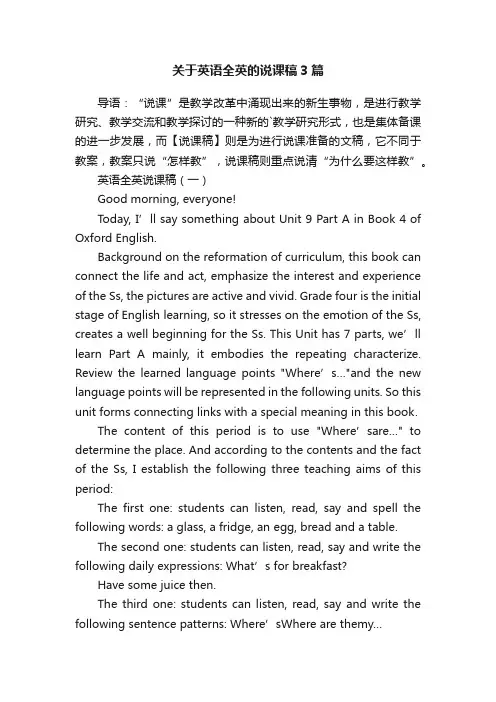
关于英语全英的说课稿3篇导语:“说课”是教学改革中涌现出来的新生事物,是进行教学研究、教学交流和教学探讨的一种新的`教学研究形式,也是集体备课的进一步发展,而【说课稿】则是为进行说课准备的文稿,它不同于教案,教案只说“怎样教”,说课稿则重点说清“为什么要这样教”。
英语全英说课稿(一)Good morning, everyone!Today, I’ll say something about Unit 9 Part A in Book 4 of Oxford English.Background on the reformation of curriculum, this book can connect the life and act, emphasize the interest and experience of the Ss, the pictures are active and vivid. Grade four is the initial stage of English learning, so it stresses on the emotion of the Ss, creates a well beginning for the Ss. This Unit has 7 parts, we’ll learn Part A mainly, it embodies the repeating characterize. Review the learned language points "Where’s…"and the new language points will be represented in the following units. So this unit forms connecting links with a special meaning in this book.The content of this period is to use "Where’sare…" to determine the place. And according to the contents and the fact of the Ss, I establish the following three teaching aims of this period:The first one: students can listen, read, say and spell the following words: a glass, a fridge, an egg, bread and a table.The second one: students can listen, read, say and write the following daily expressions: What’s for breakfast?Have some juice then.The third one: students can listen, read, say and write the following sentence patterns: Where’sWhere are themy…It’s They’re…There’s no …in on ear…I think the most difficult point of this period is to make sure the students can use the patterns "Where’sWhere are…and There is no …inon ear…" in their daily life correctly.And I will use some pictures, words and sentence cards, a tape recorder and the multi-media computer to help me achieve the aims.The task-based method, communicated method, group cooperate method will be used in this period.To accomplish the aims, I design the following steps:Step 1 Songs and the game arousers the emotion.In order to attract the Ss’ attention and construct an atmosphere of learning English, I let the students sing some English songs and play the game "Simon says". At the same time the game can review the prep, serve the knowledge as foil and consist the appearance of the knowledge.Step 2 Change class to life, happy to say.The substance of language is communication and the environment of communication is life. So when I present the sentence pattern "What’s for breakfast?" I first show a clock to elicit the time for breakfast, teach the sentence. Then show my own photo of having breakfast, Ss ask and guess. In this way I can attract Ss’ attention, encourage Ss to ask Qs with the new knowledge.Most of the Ss have learnt the sentence pattern: Where’s…?so I design a task for Ss to help Helen find the food and drinks for breakfast, and teach the new language points: Where are…?They’re … Meanwhile stick the sentences on the Bb.After some practice by asking and answering, I present thenext language points:There’s no …inon ear…Have …then.And I will stick these sentence patterns on the Bb. Finally I’ll let the Ss do pair works to consolidate them.Step 3 Listen to the tape and Ss imitate to read and say.As the new reformation of curriculum, emphasized the traditional class attach importance to the mechanical teaching, neglect the experience and participation, for example, the five-step method. So in this lesson, after presentation, I ask Ss to listen to the tape with three Qs, read in different roles and in pairs, then try to recite the text.Step 4 Ss be the main body, T makes a guider.In class, Ss play as a host, and the T makes an influence on guiding, help Ss to act the learnt dialogue, it can stress the position of the Ss, and arouse their interest.Then I show a carton with no voice, ask Ss to make a dialogue in pairs.There are lots of ways to consolidate the new knowledge. Playing game is a good way. So according to the physiology of Ss, I hold a group competition during the game, ask Ss to finish the blanks. In this way can develop Ss’ good habits and ac hieve the aim of mastering the learned knowledge in situation.Step 5 Change class to life, learn by themselves.Is this the end of the class? I don’t think so. If there is an end, I think it should be in the life. So I extend this class, encourage Ss to use the learned to communicate with each other in their life.In a word, the whole period is based on tasks, which are designed from easy steps to steps that are challenging. When theSs are carting out the tasks, they can acquire information, knowledge, and have their ability and skills trained.That’s all. Thanks a lot for your attention.英语全英说课稿(二)InterpretationGood morning, ladies and gentlemen. It’s my great honor and pleasure to be here sharing my lesson with you.I have been ready to begin this representation with five parts. Analysis of the teaching material, the teaching aims, the important and difficult points, the studying methods, and the teaching procedure.Part 1 Teaching MaterialThe content of my lesson is New Senior English for China Book___ Unit____________________. This unit is about____________________ (topics)。
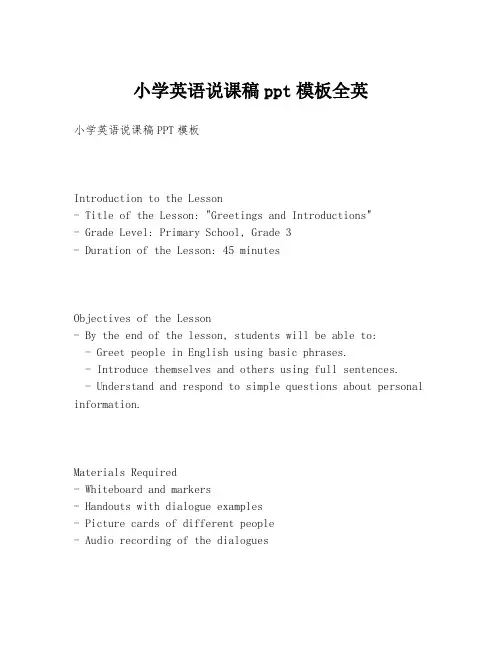
小学英语说课稿ppt模板全英小学英语说课稿PPT模板Introduction to the Lesson- Title of the Lesson: "Greetings and Introductions"- Grade Level: Primary School, Grade 3- Duration of the Lesson: 45 minutesObjectives of the Lesson- By the end of the lesson, students will be able to:- Greet people in English using basic phrases.- Introduce themselves and others using full sentences.- Understand and respond to simple questions about personal information.Materials Required- Whiteboard and markers- Handouts with dialogue examples- Picture cards of different people- Audio recording of the dialoguesTeaching Aids- PowerPoint slides with visual aids- Interactive games for practice- Role-play scenariosLesson Plan1. Warm-up Activity (5 minutes)- Greet the class and ask how they are feeling today.- Engage students in a quick game of "Simon Says" to get them moving and focused.2. Introduction of New Vocabulary (10 minutes)- Introduce key vocabulary words such as "hello," "good morning," "my name is," and "what's your name?"- Use picture cards to demonstrate the use of each phrase.3. Presentation of Dialogues (10 minutes)- Show PowerPoint slides with dialogue examples.- Play an audio recording of native speakers using the phrases.4. Practice with Chants (5 minutes)- Teach students a simple chant to help them remember the phrases.- Have the class repeat the chant together.5. Interactive Games (10 minutes)- Divide the class into groups and have them play a "WhoAm I?" game where they guess each other's names.- Use role-play scenarios where students introduce themselves to a new friend.6. Consolidation through Role-Play (5 minutes)- Assign each student a role and have them practice introducing themselves to the class.Assessment- Observe students during role-play and group activities to assess their understanding and use of the phrases.- Provide a short quiz at the end of the lesson to reinforce learning.Closure- Summarize the key points of the lesson.- Encourage students to practice greetings and introductions with their family and friends.Reflection- Reflect on the lesson's effectiveness and areas for improvement.- Consider student feedback and make adjustments for future lessons.Additional Resources- Links to online games and activities for further practice. - Suggested reading materials for students who want to expand their vocabulary.This template provides a comprehensive structure for a lesson plan focused on greetings and introductions in English for primary school students. Adjustments can be made based on the specific needs and abilities of the students.。
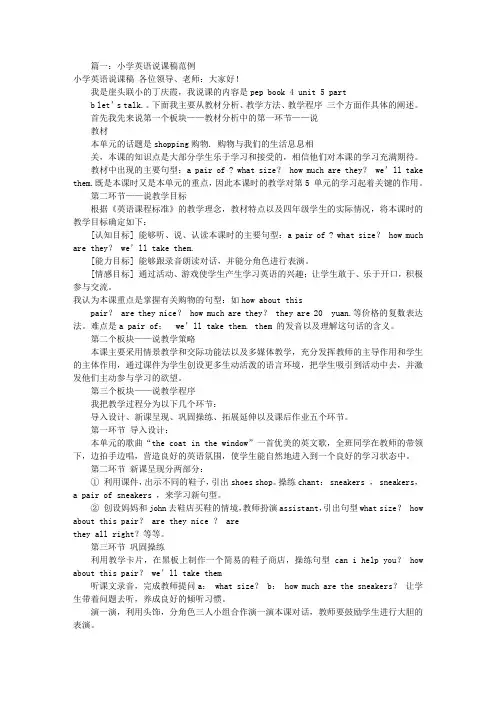
篇一:小学英语说课稿范例小学英语说课稿各位领导、老师:大家好!我是崖头联小的丁庆霞,我说课的内容是pep book 4 unit 5 partb let’s talk.。
下面我主要从教材分析、教学方法、教学程序三个方面作具体的阐述。
首先我先来说第一个板块——教材分析中的第一环节——说教材本单元的话题是shopping购物. 购物与我们的生活息息相关,本课的知识点是大部分学生乐于学习和接受的,相信他们对本课的学习充满期待。
教材中出现的主要句型:a pair of ? what size? how much are they? we’ll take them.既是本课时又是本单元的重点,因此本课时的教学对第5 单元的学习起着关键的作用。
第二环节——说教学目标根据《英语课程标准》的教学理念,教材特点以及四年级学生的实际情况,将本课时的教学目标确定如下:[认知目标] 能够听、说、认读本课时的主要句型:a pair of ? what size? how much are they? we’ll take them.[能力目标] 能够跟录音朗读对话,并能分角色进行表演。
[情感目标] 通过活动、游戏使学生产生学习英语的兴趣;让学生敢于、乐于开口,积极参与交流。
我认为本课重点是掌握有关购物的句型:如how about thispair? are they nice? how much are they? they are 20 yuan.等价格的复数表达法。
难点是a pair of; we’ll take them. them 的发音以及理解这句话的含义。
第二个板块——说教学策略本课主要采用情景教学和交际功能法以及多媒体教学,充分发挥教师的主导作用和学生的主体作用,通过课件为学生创设更多生动活泼的语言环境,把学生吸引到活动中去,并激发他们主动参与学习的欲望。
第三个板块——说教学程序我把教学过程分为以下几个环节:导入设计、新课呈现、巩固操练、拓展延伸以及课后作业五个环节。
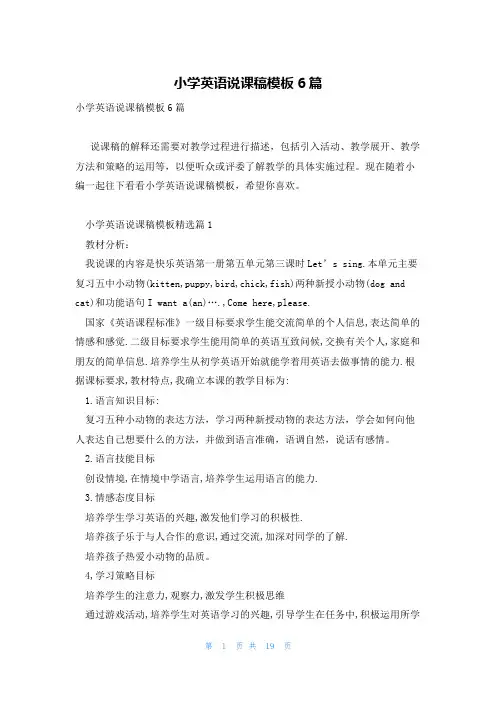
小学英语说课稿模板6篇小学英语说课稿模板6篇说课稿的解释还需要对教学过程进行描述,包括引入活动、教学展开、教学方法和策略的运用等,以便听众或评委了解教学的具体实施过程。
现在随着小编一起往下看看小学英语说课稿模板,希望你喜欢。
小学英语说课稿模板精选篇1教材分析:我说课的内容是快乐英语第一册第五单元第三课时Let’s sing.本单元主要复习五中小动物(kitten,puppy,bird,chick,fish)两种新授小动物(dog and cat)和功能语句I want a(an)….,Come here,please.国家《英语课程标准》一级目标要求学生能交流简单的个人信息,表达简单的情感和感觉.二级目标要求学生能用简单的英语互致问候,交换有关个人,家庭和朋友的简单信息.培养学生从初学英语开始就能学着用英语去做事情的能力.根据课标要求,教材特点,我确立本课的教学目标为:1.语言知识目标:复习五种小动物的表达方法,学习两种新授动物的表达方法,学会如何向他人表达自己想要什么的方法,并做到语言准确,语调自然,说话有感情。
2.语言技能目标创设情境,在情境中学语言,培养学生运用语言的能力.3.情感态度目标培养学生学习英语的兴趣,激发他们学习的积极性.培养孩子乐于与人合作的意识,通过交流,加深对同学的了解.培养孩子热爱小动物的品质。
4,学习策略目标培养学生的注意力,观察力,激发学生积极思维通过游戏活动,培养学生对英语学习的兴趣,引导学生在任务中,积极运用所学英语进行表达与交流.教学重点:对单词cat和dog的教学,对功能语句Come here,please.的操练。
教学难点:能够灵活使用I want a(an)….来表达自己的意愿。
教具,学具准备:教具:7种小动物的图片,dog和cat的卡片,多媒体课件,5个信封学具:教材学情分析:学习本课之前,学生们已经在本单元的第一课时学习了5种小动物的表达方方法,在第二课时学习了I w ant a(an)…为学习本课打下了良好的知识基础。
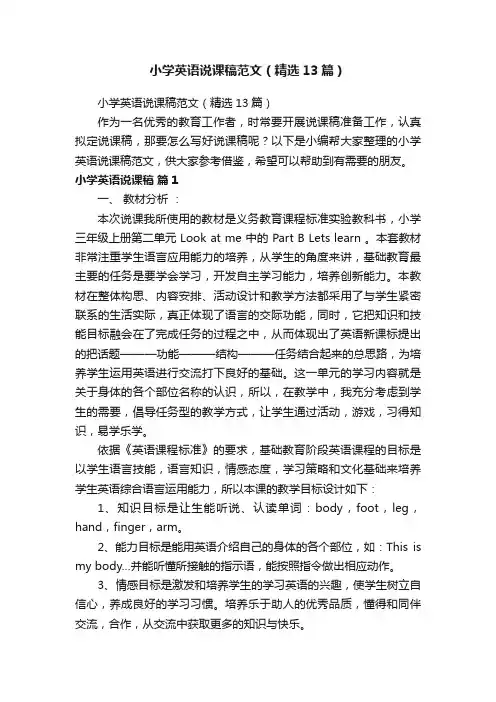
小学英语说课稿范文(精选13篇)小学英语说课稿范文(精选13篇)作为一名优秀的教育工作者,时常要开展说课稿准备工作,认真拟定说课稿,那要怎么写好说课稿呢?以下是小编帮大家整理的小学英语说课稿范文,供大家参考借鉴,希望可以帮助到有需要的朋友。
小学英语说课稿篇1一、教材分析:本次说课我所使用的教材是义务教育课程标准实验教科书,小学三年级上册第二单元 Look at me 中的 Part B Lets learn 。
本套教材非常注重学生语言应用能力的培养,从学生的角度来讲,基础教育最主要的任务是要学会学习,开发自主学习能力,培养创新能力。
本教材在整体构思、内容安排、活动设计和教学方法都采用了与学生紧密联系的生活实际,真正体现了语言的交际功能,同时,它把知识和技能目标融会在了完成任务的过程之中,从而体现出了英语新课标提出的把话题———功能———结构———任务结合起来的总思路,为培养学生运用英语进行交流打下良好的基础。
这一单元的学习内容就是关于身体的各个部位名称的认识,所以,在教学中,我充分考虑到学生的需要,倡导任务型的教学方式,让学生通过活动,游戏,习得知识,易学乐学。
依据《英语课程标准》的要求,基础教育阶段英语课程的目标是以学生语言技能,语言知识,情感态度,学习策略和文化基础来培养学生英语综合语言运用能力,所以本课的教学目标设计如下:1、知识目标是让生能听说、认读单词:body,foot,leg,hand,finger,arm。
2、能力目标是能用英语介绍自己的身体的各个部位,如:This is my body…并能听懂所接触的指示语,能按照指令做出相应动作。
3、情感目标是激发和培养学生的学习英语的兴趣,使学生树立自信心,养成良好的学习习惯。
培养乐于助人的优秀品质,懂得和同伴交流,合作,从交流中获取更多的知识与快乐。
本课的教学重点:单词body,foot,leg,arm。
finger,hand 的听说认读。
小学英语说课稿全英文模板Ladies and gentlemen,Today, I am honored to present to you a comprehensive lesson plan for an elementary English class. This lesson plan is designed to be engaging, interactive, and effective in helping young learners grasp the basics of English language skills.IntroductionGood morning, class! My name is [Your Name], and I am your English teacher for today. We are going to embark on a fun and exciting journey into the world of English. Let's get started!ObjectivesThe primary objectives of this lesson are to:1. Introduce and practice basic English vocabulary related to colors.2. Enhance students' listening and speaking skills through interactive activities.3. Foster a positive attitude towards learning English as a second language.MaterialsFor this lesson, we will need:- Colored flashcards- A set of markers in various colors- A whiteboard and markers- Audio equipment for listening exercises- A classroom set of English picture booksWarm-up ActivityLet's begin with a warm-up activity to get everyone comfortable. We will play a simple game called "What's My Color?" I will hold up a colored flashcard and you will tell me the color in English. Ready? Let's go!Vocabulary IntroductionNow, let's learn some new words. Today, we are going to talk about colors. Here are the colors we will learn: red, blue, green, yellow, and orange. Let's repeat them together: red, blue, green, yellow, orange.Interactive LearningWe will use these colors in a drawing activity. I will give each group a set of markers and ask you to draw something you like using the colors we've learned. After you finish, wewill share our drawings with the class and describe what we drew using the colors.Listening ExerciseNext, we will listen to a short story about a rainbow. Pay attention to the colors mentioned in the story. After listening, we will discuss the story and identify the colors we heard.Speaking PracticeFor the speaking practice, we will play a game called "Color Your World." I will describe an object, and you will tell me the color you would paint it. For example, if I say "The sky," you might respond with "I would paint it blue."ClosureAs we come to the end of our lesson, let's review what we've learned today. We've learned the names of five colors and practiced using them in various activities. Remember,practice makes perfect. Keep using these words and you'll become a master in no time!HomeworkFor homework, I would like you to create a small poster with the colors we've learned today. Draw something simple and write the color names next to it. Bring it to class tomorrow, and we will share our creations.ConclusionThank you for your attention and participation in today's English class. I hope you enjoyed our activities and learnedsomething new. Keep up the great work, and I look forward to seeing you all next time.That concludes my lesson plan. I am open to any questions or suggestions you may have to improve this plan further.Thank you.。
小学英语全英文说课稿范例 The lesson I am going to talk about is from the teaching material Book One ,Unit 8 .the third part that is used by the kids in Grade One .
一、Analysis of the teaching material (说教材) This is a dialogue that happens in the fruit shop .several sentences surround selling and buying the fruit will be learned .During the first and the second part in this unit ,the kids have understood simple instructions and act accordingly ,and they can say simple words ,phrases or sentences by looking at objects and the pictures .eg: lychee, banana, apple,“What’s this ?It’s an apple.”In Unit seven ,we grasped the numbers from one to ten .The main language points in this unit is to make sentences using the fruit and numbers freely and communicate with others in English in the fruit shop. And pay close attention to the single and plural forms of the nouns .According to the kids’ English level and the corresponding content in the daily life ,I give them some extra extending .To train their ability of communicate with the others in English ,I prepare the following design .
Teaching aims (教学目标) 1. knowledge and skill aims :(知识技能目标) Review the names of the ten different kinds of fruit and recognize the numbers from one to ten .
Understand simple instructions about the numbers and act accordingly. Practice English and communicate with others in the situation. 2. Equip them with the emotion ,attitude and value goals :(情感、态度、价值目标)
Cultivate the spirit of co-operations in the group work..
Bring up the good quality of protect and make friends with the animals .
Teaching importance :(教学重点) 1. Make sentences using the fruit and the numbers . “Six oranges ,please .’
2. Distinguish the difference between the single form and the plural forms of the nouns .“one apple / two apples …”
3. The sentences used when selling and buying the fruit in a fruit shop.
Teaching difficulties :(教学难点) 1. Distinguish the difference between the single and the plural forms of the nouns .
2. Train their ability of communicating with others in English .
Teaching aids ;(教具准备) Multimedia , flash cards ,fresh fruit and arrangements and decorations of the fruit shop .
Teaching methods :(教学方法) Task objective teaching method .TPR method , performance and games methods .
二、Analysis of the learners :(说学习者) We are facing the 5 to 6-year-old little kids who just graduated from the kindergarten ,and they can not tell the difference between kindergarten and the primary school. sometimes they even don’t know how to behave in the class. So ,I think the most important thing for me to do is to attract their interests and make them love English and feel confident in this subject .so ,I will play some interesting games with them ,show them the funny cartoon movie and role the plays in the text or have a competation. we should not only focus on the language point itself ,but also set up the real circumstance where I can encourage them to express themselves better .What I try my best to do is to arouse the kids’ interests and protect their enthusiasm。
三、Analysis of the teaching methods (说教法) says that during the Foundation Education period ,the total goal for English lesson is to improve the pupils’ ability of comprehensive using language .It promotes task teaching structure .According to the little kids’ physical and psychological characteristics of keeping curios ,active and imitating and showing themselves .I adopt the “task –research—construct ” teaching methods and organize the class to focus on the importance and solve the difficulties .I give the pupils an open and relaxed circumstance in which they can learn to observe ,think and discuss .during this procedure ,the pupils’ ability of thinking and using language is developed very well .
四、Analysis of the teaching procedures .(说教学过程) 1. Warm up .(歌曲热身) All the class sing English song “Ten little Indian boys ” to arouse their interests and help them to step into English learning circumstance happily.
2. Review the fruit and the numbers those we learned in the first and the second part in this unit .(复习数字和水果)
A. Watch a funny video . and answer the questions .(learn more fruit and practice more sentence patterns eg: strawberry / watermelon/ pineapple /cherry) ask some questions .
What’s this ? What colour is it ? How many bananas are there ? Do you like eating bananas ? What is your favourite fruit ? Encourage them to open their mouth and speak English as much as they can .